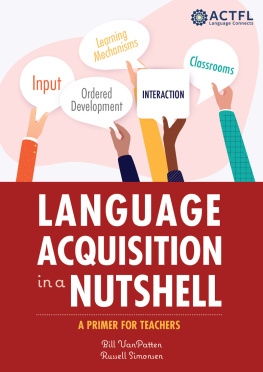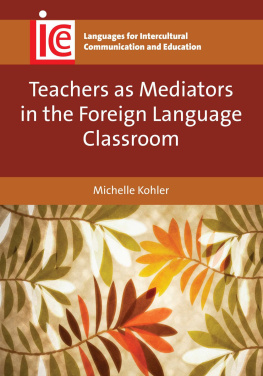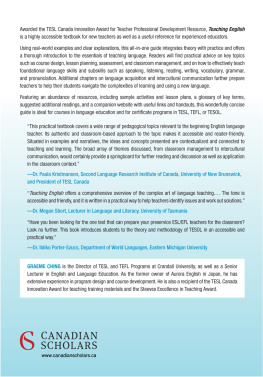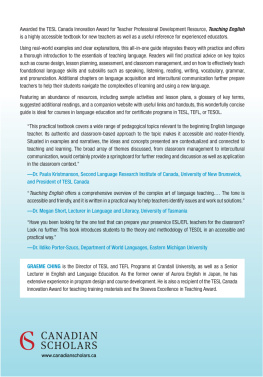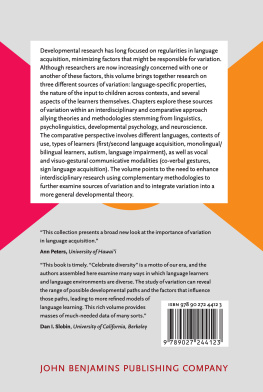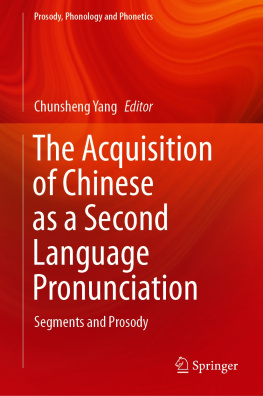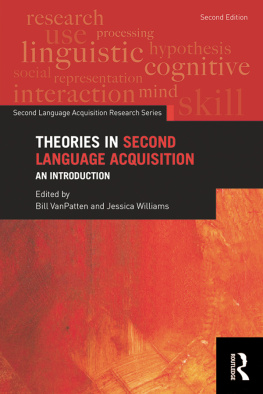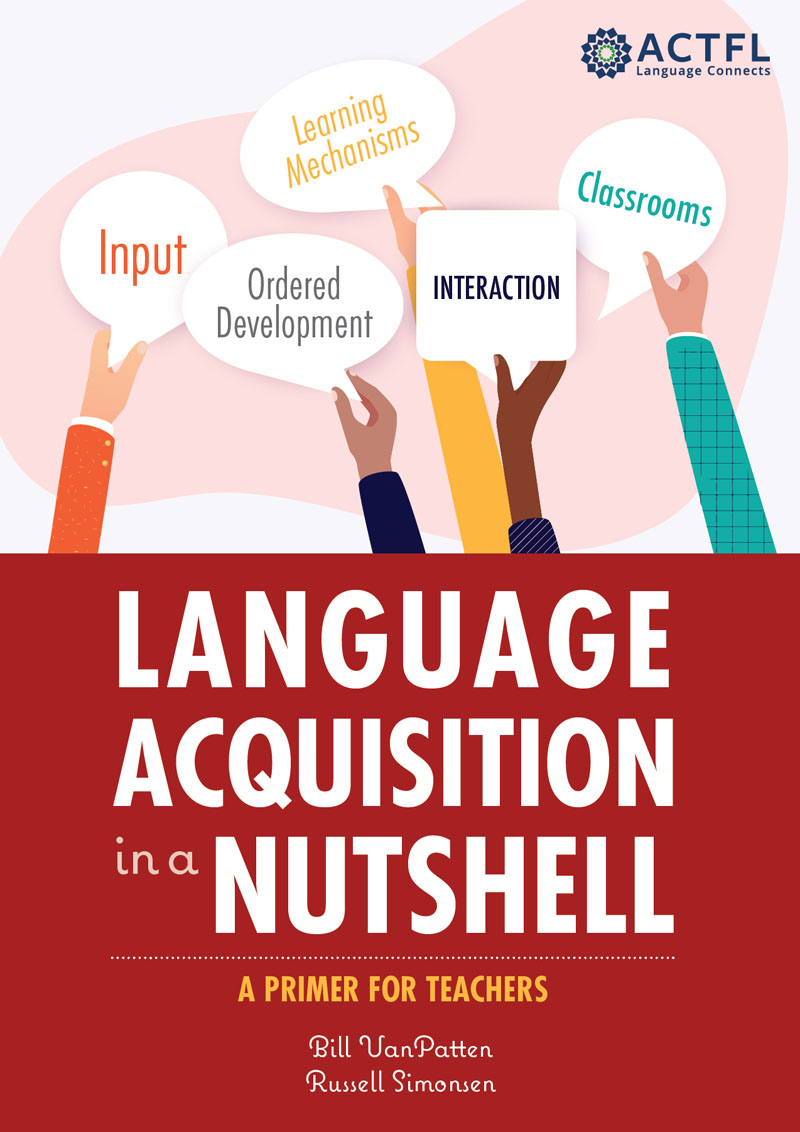

Graphic Design by Paintbox Creative
Cover illustration: istock.com/Lesia_G
ISBN: 978-1-942544-77-7
2022, ACTFL
1001 North Farifax Street, Suite 200
Alexandria, VA 22314
All rights reserved. No part of this book may be reproduced, in any form or by any means, without expressed written consent of the publisher.
ACKNOWLEDGEMENTS
Authors and scholars may seem to work alone, and while this may be true as they put fingers to keyboard, behind the scenes may be a myriad of people who deserve thanks in various ways. This is certainly true for us. First, wed like to thank our friends and families who have always supported us in our academic endeavors. You know who you are. Second, wed like to thank the many scholars in linguistics and language acquisition whose work over the years influenced us or with whom weve had important conversations about the topics found in this book. We wish we could list them all. Some of them are found in our readings. Others, well, theyll just have to accept here that we appreciate our interactions with them. Third, we thank all the folks at ACTFL who helped to make this book happen. We are especially indebted to Joe Vallina and Meg Malone, who worked with us on all phases of this project from beginning to end. Our very special thanks. Finally, we thank all the teachers who, throughout the years, have asked us questions, raised their hands at presentations and workshops, and otherwise pushed us to be the best we could be as teacher-scholars.
To all my former students. BVP
In memory of Joan Simonsen RS
TABLE OF CONTENTS
Prologue
In this book, we focus on second language and how it is acquired. A natural question a reader might ask is, What does this have to do with teaching, and why read this book?
Lets start with decision-making. Teachers make decisions all the time. They make decisions on which textbook to use or whether or not to use a textbook at all. They make decisions about what activities to use in the classroom and on student assessment. They read standards and guidelines from professional organizations and make determinations about their meanings. How do teachers make these and other decisions?
Our belief is that the best teacher decisions are informed decisionsthat is, teachers make decisions based on a variety of sources for which they must be informed, including, but not limited to,
- the age and level of the learner,
- availability of materials,
- technological tools,
- the context in which they teach,
- state and local mandates,
- societal expectations,
- the nature of communication,
- the nature of language, and
- the nature of acquisition.
In our experience, the latter three items (especially the last two) are the ones that many teachers are underprepared for in their decision-making process. Without citing specific names and materials, weve surveyed a number of publications used in teacher preparation courses, as well as professional and regional sites with guidelines, standards, and so on. Surprisingly, the nature of language and language acquisition are the most underrepresented topics in such materials. In fact, in some cases, language and language acquisition are absent altogether. One possible reason is that teachers and teacher educators assume what language is and may use their own experiences to fashion some understanding of the nature of language acquisition. Experience can be useful, but it can also be limiting. Consider the following example: A teacher has completed an undergraduate degree in teacher education in a language (e.g., French). The teachers only exposure to language has been in textbooks she used as a student of French language. Her only exposure to acquisition has been what she believes she has undergone because of what she was asked to do as a student. These limited exposures mean the teacher arrives at an understanding of language acquisition that looks like the following:
- The language rules and grammar presented in language textbooks must be what we acquire and what wind up in our heads.
- Non-children learn languages by studying, memorizing, practicing, and taking tests.
These conclusions may then be reinforced by teacher education curricula because the nature of language and language acquisition are largely absent from the teachers formal education. In this scenario, language is a subject matter similar to history, math, or science. The teacher only needs general principles of education and learning. This teacher, then, may make decisions without consideration for the nature of language and how language is acquired over time.
The purpose of this book, then, is to put some basic notions about language and language acquisition into teachers hands so they have additional tools and information with which to make as informed decisions as possible. After all, language teachers are language teachers. They arent history teachers or math teachers. So, one would reasonably expect theyd be as informed as possible about the very focus of their efforts. With that said, do we mean to imply that once teachers read this book they will know what to teach and how to teach it? No. We will touch on this topic again in our final frequently asked question in .
This book is meant to provide a brief introduction to language and language acquisition. Nothing presented in this book is controversial (in our estimation). On topics where there might be some disagreement, however, we point out that possibility and discuss why the disagreement may not be much of a disagreement after all. Our goal is to engage teachers about issues at the heart of what they do. We are not here to tell teachers how to teach or what to teach. We simply want teachers to be as informed as possible as they make decisions about what they do and what they expect of their learnersand perhaps what they expect of themselves.
How to Use This Book
Merriam-Webster defines primer as a small introductory book on a subject. As a primer, this book is not meant for a course on language acquisition. There are lots of thick books out there that cover the A to Z of language and language acquisition and are more suitable for courses on second language (L2) acquisition. Our goal for this book is different. We understand that teachers are busy, so we purposefully kept this book short and focused on offering the basics. Those basics are culled from our experience in working with teachers over the years in professional development workshops and talks, as well as in courses weve taught that focus on language teaching and the questions that come up in classroom discussion. As such, this book can be used in a number of ways:
- It can be used in teacher preparation courses as a supplement to other books and materials. The books brevity means it can be slipped in over a period of several weeks.
- It can be used for professional development workshops as background reading or a reference.
- It can be used in book discussion groups led by teachers and local and state supervisors.
- It can be read by any individual on a rainy or snowy weekend.
Overview of This Book
Here are some features in each chapter that you may find useful, as well as the intent behind them:
Next page
